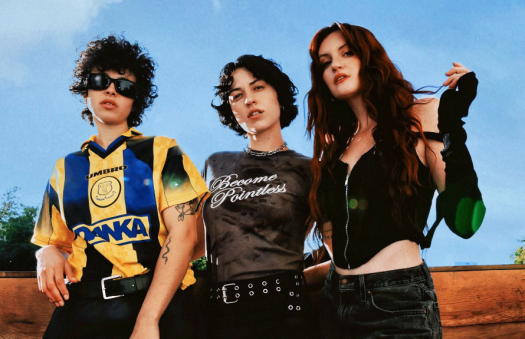Samplers, DAT machines, MIDIs, miscellaneous synthesisers ? electronic studio technology is a technocratic entertainment executive's wet dream. Just think of the efficiencies to be gleaned! Machines and chips can do all the work of writing and recording, with no difficult artistic temperaments to deal with. You can compose using computer files; musical collaboration increasingly means exchanging diskettes and sending email attachments back and forth.
Guy Fixsen knows his way around electronic studio gadgetry as well as anyone. In fact, along with Margaret Fiedler, the other permanent half of Laika, he yielded to the temptation to let the electronics perform a disproportionate share of the workload with their second album, Sounds of the Satellites. He confesses to being a little disappointed with how that album turned out and disillusioned with the way programming has supplanted songwriting and actual performance among some electronica artists.
"To be honest, I find it's tedious going to shows at the moment," Fixsen grouses from his home in London, England. "Too many bands sit at a mixing desk with a DAT, and they press a couple of buttons, and presto, it's a live performance. It's true that technology has informed writing and live performance for a long time, and the more you get into the technology, the more you can do, but only if you listen. What frustrates me most is that most people using this technology aren't self-critical. We're more of the mind that if you're gonna release something, it should be special ? there's definitely enough music in the world, that's for sure."
Laika has reverted to a live performance rock aesthetic for their latest, Good Looking Blues, and let the chips fall where they may. The organic sound of the album is owing in part to improvising on live instruments and using the ample technology at their disposal to edit their jams down to something usable ? but by no means spartan. Good Looking Blues is nearly extravagant in its arrangements. Beats nearly as claustrophobic as drum & bass, ping-ponging analog keyboards, and whirling, capering samples orbit elliptically around tough bass grooves of a super-bad vintage. The post-rock tag may still feel velcroed to Laika, but they've never sounded so bristling with life. And while Laika compromise none of their adventurous spirit, Fiedler's melodies and vocals, a vaguely unsettling blend of sangfroid and contained panic, are the fulcrum as never before. Good Looking Blues might also seem too flat out funky and pleasurable for anyone who thinks truly innovative music must require ascetic discipline to listen to.
"Dark, funky and live ? those are the three words that went into making this album," says Fixsen, whose most recent production work has been for King Cobb Steelie. "We also started thinking that if you want to make music that's lasting and makes a human impact, you need a vocalist. That's not to say instrumental music is inhuman or cold ? think King Tubby or Miles Davis." (In fact, Good Looking Blues' "Widows' Weed" strikes a mid-70s Miles groove.) "But in the post-Tortoise world, instrumentalism has come to mean experimental," Fixsen continues. "We say you can be both ? emotional and experimental."
Accordingly, the blues motif extends beyond the album title and the opening song, "Black Cat Bone," an overt allusion to blues lore. Blues are still among the earthiest of genres and one of the last remaining genres whose authenticity is measured by how low tech it is ? the rawer and less polished, the more compelling the blues are. Laika's reinterpreting of the blues here isn't exactly borne of a refusal of technology ? Good Looking Blues is, after all, a great-sounding album ? but an aesthetic framework through which to square the electronic with the human.
"I guess this is our way of saying there's more than one way of playing the blues ? it's a bigger term than black Southern music. The reference to blues in general is about Margaret and her lyrics. She's influenced by Zora Neale Hurston and Toni Morrison and a lot of Southern black writers, and their writing is like the blues: they're gritty and lyrical. Blues is music you can relate to ? it's about very grounded things like sex, work, love. We'd made a couple of records with space-themed titles [Silver Apples of the Moon and Sounds of the Satellites], and with this, it's like we returned to earth. We're focussing on now instead of elsewhere and the intangible."
Their name still connects them to space, though. Laika the Russian dog was the first breathing thing to be sent into space, howling silently to its death in airless orbit. An impressive display of technology for its time, but a little crude by today's standards. And therein lies the curious appeal of the early space age for Laika, which they invoke with the imagery and language of Soviet kitsch and retro-futurism, not to mention their sounds and choice of audio technology. Laika have a playful relationship with musical technology, similar to former Too Pure label-mates like Stereolab, with their quaintly droning Moogs, or the whimsical, mad nursery music of Pram, or even electronic duo Mouse on Mars. Laika's taste runs to machines that are just a little inefficient and sounds that are just a little inelegant. Their organs are anything but transparent simulations of other sounds; they sound just like the Moogs, Clavinets, and Fender Rhodes that they are. If you could actually hear the gears turning or tubes glowing inside the instruments, they'd probably be happier still.
Those were the futuristic sounds of 40-plus years ago, a time when people wondered at technology. It was our promise and our future, but it also seemed ponderous, clanking, unwieldy and even a little comical. Now, technology is a threat and a scold. "Are you ready?" the ads badger us. "Don't get left behind." They're no luddites, but they're wary of contemporary techno-culture, preferring an age when innovation was about preposterous visions, not IPOs and e-business solutions, keeping us contentedly suckling at silicon teats of high tech spectacle like so many subjects of The Matrix.
"We're kind of nostalgic for that kind of wide-eyed optimism in the 50s and 60s, when space travel seemed almost surreal," Fixsen explains. "But when we use those sounds, it's more as a sort of metaphor for experimentation than an attempt to recreate 50s and 60s music. There is that Soviet kitschiness to the band name, and we're stuck with that, but we certainly don't like things that work too well ? you know, that's what the space age Soviet era makes you think of. We like things that don't work perfectly, where the ambition is greater than the ability to pull it off. And our playfulness with Soviet kitsch extends to our artwork, and it extends to our aesthetic as people. It's how we strike a balance between the human and the futuristic."
Guy Fixsen knows his way around electronic studio gadgetry as well as anyone. In fact, along with Margaret Fiedler, the other permanent half of Laika, he yielded to the temptation to let the electronics perform a disproportionate share of the workload with their second album, Sounds of the Satellites. He confesses to being a little disappointed with how that album turned out and disillusioned with the way programming has supplanted songwriting and actual performance among some electronica artists.
"To be honest, I find it's tedious going to shows at the moment," Fixsen grouses from his home in London, England. "Too many bands sit at a mixing desk with a DAT, and they press a couple of buttons, and presto, it's a live performance. It's true that technology has informed writing and live performance for a long time, and the more you get into the technology, the more you can do, but only if you listen. What frustrates me most is that most people using this technology aren't self-critical. We're more of the mind that if you're gonna release something, it should be special ? there's definitely enough music in the world, that's for sure."
Laika has reverted to a live performance rock aesthetic for their latest, Good Looking Blues, and let the chips fall where they may. The organic sound of the album is owing in part to improvising on live instruments and using the ample technology at their disposal to edit their jams down to something usable ? but by no means spartan. Good Looking Blues is nearly extravagant in its arrangements. Beats nearly as claustrophobic as drum & bass, ping-ponging analog keyboards, and whirling, capering samples orbit elliptically around tough bass grooves of a super-bad vintage. The post-rock tag may still feel velcroed to Laika, but they've never sounded so bristling with life. And while Laika compromise none of their adventurous spirit, Fiedler's melodies and vocals, a vaguely unsettling blend of sangfroid and contained panic, are the fulcrum as never before. Good Looking Blues might also seem too flat out funky and pleasurable for anyone who thinks truly innovative music must require ascetic discipline to listen to.
"Dark, funky and live ? those are the three words that went into making this album," says Fixsen, whose most recent production work has been for King Cobb Steelie. "We also started thinking that if you want to make music that's lasting and makes a human impact, you need a vocalist. That's not to say instrumental music is inhuman or cold ? think King Tubby or Miles Davis." (In fact, Good Looking Blues' "Widows' Weed" strikes a mid-70s Miles groove.) "But in the post-Tortoise world, instrumentalism has come to mean experimental," Fixsen continues. "We say you can be both ? emotional and experimental."
Accordingly, the blues motif extends beyond the album title and the opening song, "Black Cat Bone," an overt allusion to blues lore. Blues are still among the earthiest of genres and one of the last remaining genres whose authenticity is measured by how low tech it is ? the rawer and less polished, the more compelling the blues are. Laika's reinterpreting of the blues here isn't exactly borne of a refusal of technology ? Good Looking Blues is, after all, a great-sounding album ? but an aesthetic framework through which to square the electronic with the human.
"I guess this is our way of saying there's more than one way of playing the blues ? it's a bigger term than black Southern music. The reference to blues in general is about Margaret and her lyrics. She's influenced by Zora Neale Hurston and Toni Morrison and a lot of Southern black writers, and their writing is like the blues: they're gritty and lyrical. Blues is music you can relate to ? it's about very grounded things like sex, work, love. We'd made a couple of records with space-themed titles [Silver Apples of the Moon and Sounds of the Satellites], and with this, it's like we returned to earth. We're focussing on now instead of elsewhere and the intangible."
Their name still connects them to space, though. Laika the Russian dog was the first breathing thing to be sent into space, howling silently to its death in airless orbit. An impressive display of technology for its time, but a little crude by today's standards. And therein lies the curious appeal of the early space age for Laika, which they invoke with the imagery and language of Soviet kitsch and retro-futurism, not to mention their sounds and choice of audio technology. Laika have a playful relationship with musical technology, similar to former Too Pure label-mates like Stereolab, with their quaintly droning Moogs, or the whimsical, mad nursery music of Pram, or even electronic duo Mouse on Mars. Laika's taste runs to machines that are just a little inefficient and sounds that are just a little inelegant. Their organs are anything but transparent simulations of other sounds; they sound just like the Moogs, Clavinets, and Fender Rhodes that they are. If you could actually hear the gears turning or tubes glowing inside the instruments, they'd probably be happier still.
Those were the futuristic sounds of 40-plus years ago, a time when people wondered at technology. It was our promise and our future, but it also seemed ponderous, clanking, unwieldy and even a little comical. Now, technology is a threat and a scold. "Are you ready?" the ads badger us. "Don't get left behind." They're no luddites, but they're wary of contemporary techno-culture, preferring an age when innovation was about preposterous visions, not IPOs and e-business solutions, keeping us contentedly suckling at silicon teats of high tech spectacle like so many subjects of The Matrix.
"We're kind of nostalgic for that kind of wide-eyed optimism in the 50s and 60s, when space travel seemed almost surreal," Fixsen explains. "But when we use those sounds, it's more as a sort of metaphor for experimentation than an attempt to recreate 50s and 60s music. There is that Soviet kitschiness to the band name, and we're stuck with that, but we certainly don't like things that work too well ? you know, that's what the space age Soviet era makes you think of. We like things that don't work perfectly, where the ambition is greater than the ability to pull it off. And our playfulness with Soviet kitsch extends to our artwork, and it extends to our aesthetic as people. It's how we strike a balance between the human and the futuristic."




